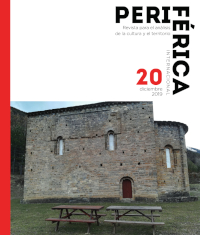Lunares prohibidos por extranjeros
Résumé
El artículo tiene como objetivo principal descubrir dónde estuvieron los lunares españoles antes de convertirse en lunares para el flamenco y hallar sus rastros en el comercio de España. Para ello, la investigación se centrará en la formación de la nación española entre 1750 y 1847. El método principal de investigación ha sido la lectura de imágenes y material gráfico relacionado con gitanos, ballet y flamenco. Nos hemos sumergido en la historia, en la etimología y en la semiótica de la palabra lunar para buscar el origen de los mismos en el estampado del típico traje de flamenca en España. En los inicios del flamenco, no era nada común poder ver a una gitana vestida con lunares. Estas vestían con faldas lisas o con otros estampados como los cuadros vichy. Para buscar el motivo de este suceso nos hemos centrado en la evolución de la industria textil que nos ha llevado a la evolución de las normas de aranceles en las aduanas y así es como pudimos ver que los lunares tuvieron vetada la entrada al comercio en España por considerarse extranjeros desde 1792, y de forma intermitente hasta 1841. Durante ese tiempo el sustantivo lunar adquirió connotaciones negativas en España, asimilándose a pecado o defecto. Al poco tiempo de que el flamenco fuera conformándose, los lunares comenzaron a verse entre la moda de las mujeres españolas.
Palabras clave: lunar, lunares, estampado, dotted swiss, aduana, gitanos, flamenco, textil.
Moles prohibited by foreigners
Abstract: The article has as main objective to discover where were Spanish dots before becoming for flamenco and find their traces in the commerce of Spain. To do this the research we will focus on the formation of the Spanish nation between 1750 and 1847. The main method of research has been the reading of images and graphic material related to gypsies, ballet and flamenco. We were immersed in the history, the etymology and semiotics of the word to find the source of the polka dots in the print of the typical flamenco dress in Spain. In the beginnings of flamenco, it was not uncommon to see a flamenco dressed with dots. The gypsy wore skirts plain or with other prints such as paintings vichy. To find the reason of this event we have focused on the evolution of the textile industry which has led us to the evolution of the rules of tariffs in the customs and this is how we were able to see that theyhad vetoed the entrance to the trade in Spain, considered as foreigners since 1792 intermittently until 1841. During that time, the noun acquired negative connotations in Spain, assimilating to sin or defect. The little time that flamenco out conforming, dots began to be seen between the fashion of the Spanish women.
Keywords: dot, dots, patterned fabric, dotted swiss, customs, gypsies, flamenco, textile.
Artículo recibido: 05/03/2019// Artículo aceptado: 17/03/2019
Mots-clés
Téléchargements
Comment citer
Licence

Este obra está bajo una licencia de Creative Commons Reconocimiento-NoComercial-SinObraDerivada 4.0 España.






